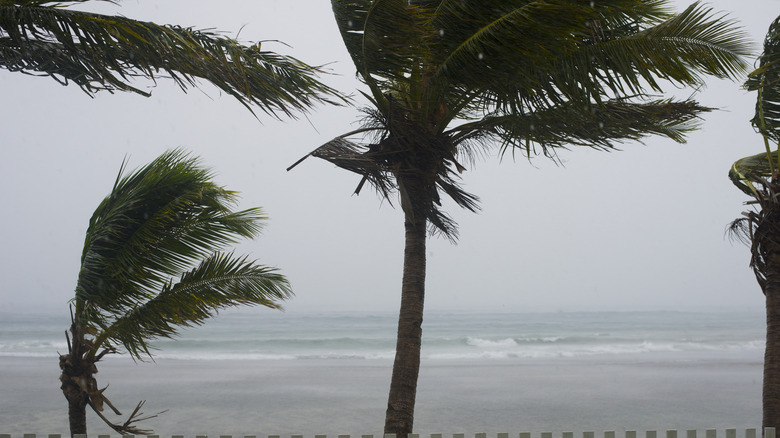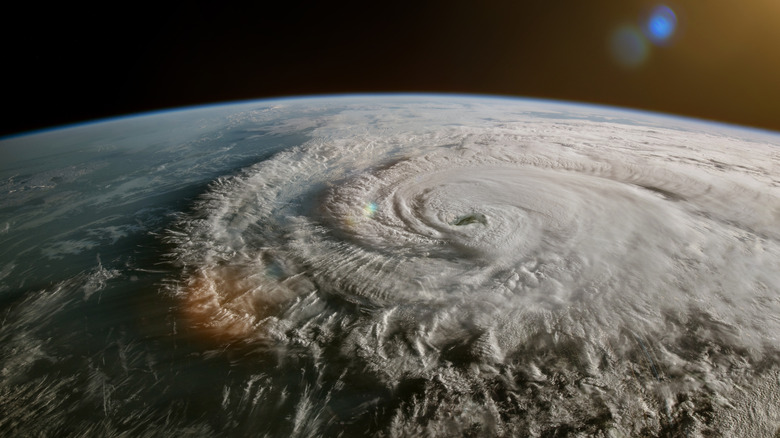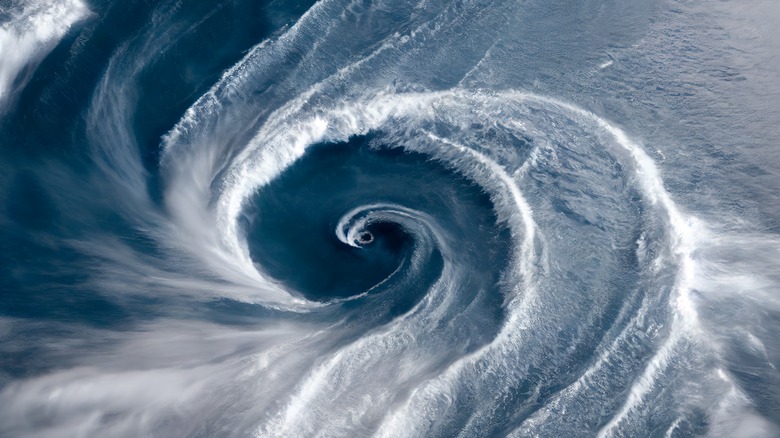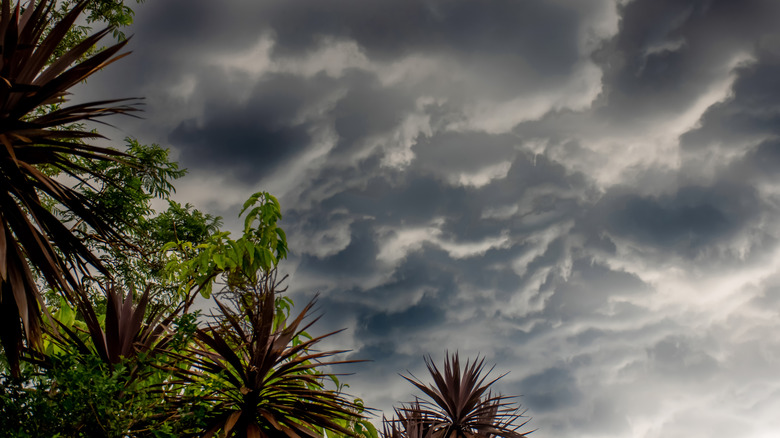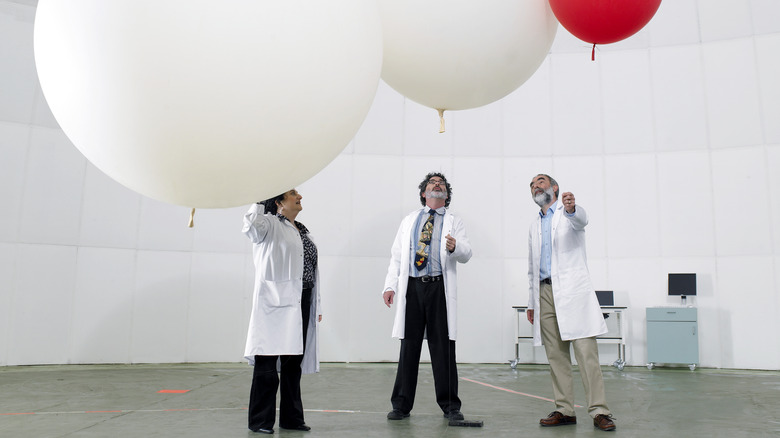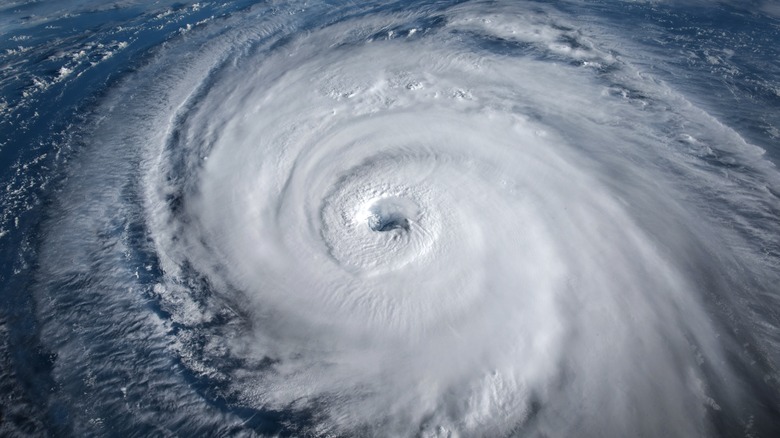What Is A Subtropical Storm?
As Florida braced itself, Tropical Storm Nicole was expected to be upgraded to a Category 1 hurricane based on its wind strength and potential damage toll. According to CNN, Nicole is predicted to hit Florida's West Palm Beach November 10. This categorization is based off of the Saffir-Simpson Hurricane Wind Scale, which rates hurricanes on a system from 1 to 5, depending on wind speed. The most severe category is 5, while 1 is the lowest (via National Oceanic and Atmospheric Administration's National Hurricane Center).
As World Atlas explains, Florida has been one of the states which has experienced the severe impact of hurricanes throughout the years, giving Floridians much to worry about and prepare for. Devastating weather phenomena include not only hurricanes, but tropical and subtropical storms. The two actually differ on a few qualities. Meteorologist language may seem cryptic at first, but the science behind the distinction is actually very straightforward.
What is a tropical storm?
Tropical cyclones are basically low-pressure storm systems that rotate rapidly. As Florida State University's Emergency Management explains, these storms often carry strong, dangerous winds, thunderstorms, and plenty of heavy rain. Tropical cyclones come in different flavors, such as hurricane, tropical storm, or tropical depression, determined by the strength of the storm. Despite its name, tropical cyclones aren't exclusive to the tropics, as they can occur all around the planet. In particular, however, coastline states like Florida and Louisiana are especially vulnerable.
According to the National Weather Service, there are a multitude of different definitions associated with tropical cyclones. A tropical disturbance is typically one of the starting points for larger storms like hurricanes, though not always. These weather systems have organized convections and 100-mile to 300-mile diameters. A tropical depression is a cyclone with wind speeds of up to 38 mph or less. Anything higher than Category 3 becomes classified as a major hurricane.
What are subtropical storms?
Adding to the base definition of a tropical storm, subtropical storms are similar, though have a bit more to them that creates a distinction. According to USA Today, there are three different storm categories that meteorologists refer to often: tropical, subtropical, and extratropical. Subtropical storms are basically a kind of hybrid of both extratropical and tropical forms. These types of subtropical storms typically have very large wind fields far away from the storm center. Subtropical storms often are birthed from extratropical storms and don't possess storm fronts.
One major key detail about subtropical storms is that they cannot quickly form into hurricanes like regular tropical storms can. As stated by Weather, subtropical storms also have circulation centers typically free of clouds and massive in size. Heavy thunderstorms also occur around 100 miles or so from the storm center. Any subtropical storm with hurricane-like winds then becomes categorized as a tropical storm.
How are tropical and subtropical storms categorized and how do they differ?
In general, subtropical and tropical storms might seem similar, but they differ in a few key areas. According to Weather, subtropical hurricanes are a non-existent category, as the hurricane designation belongs only to the tropical category. A subtropical storm can actually become fully tropical under a few conditions. This happens when a lot of storm center activity associated with tropical storms happens during a subtropical storm. If thunderstorms and strong winds start forming closer to the center, a subtropical storm could become fully tropical. These phenomena can occur if any subtropical storm occurs for a few days or more around warm water.
As USA Today states, subtropical storms weren't always well-documented and in fact didn't start to be named until 2002. With that being said, a few more traits like subtropical storms depending on temperature contrasts to get energy also distinguishes them from full tropic cyclones. Another important detail about tropical storms is that energy comes from warm ocean water heat extraction. As explained by Meteorologist Britta Merwin on Fox Weather, subtropical storms typically have a comma shape rather than the doughnut shape of a tropical storm.
How do metereologists track and predict tropical and subtropical storms?
In terms of how subtropical and tropical storms are tracked, meteorologists have a host of different methods. According to Hurricane Science, technology such as radar, buoys, reconnaissance aircraft, satellites, and so on are immensely helpful in tracking and predicting storms. Satellites can track the behavior, size, intensity and such of a subtropical or tropical storm when it appears over ocean water. There are special U.S. Air Force and NOAA aircraft dedicated to monitoring storm creation. Precipitation and wind velocity are also analyzed by land-based radars, which are also vital in prediction.
As Britannica states, before the invention of weather tracking technology, there wasn't much scientists could do to predict potential storm danger, outside of observing weather changes and ocean surfaces for effects. Nowadays, however, organizations like the World Meteorological Organization (WMO), Regional Specialized Meteorological Centres (RSMCs), and the National Oceanic and Atmospheric Administration (NOAA), can predict storms well ahead of their landing and broadcast warnings with ample time for preparation.
What are pressure systems?
Another important thing to know in understanding subtropical storms is pressure systems. As stated by SciJinks, air pressure can be thought of as basically the weight of air and its effects. The atmosphere is comprised of many different gases, which create dense layers of molecules that all exert tremendous pressure on everyone on the planet. These effects aren't actually felt by most people on a daily basis, as the human body is well-adapted to it. When an area on the planet has lower pressure than others, it is called a low-pressure system, while higher pressure means it's a high-pressure system.
According to the National Oceanic and Atmospheric Administration, air pressure is a vital component in how tropical storms manifest. Hurricanes often begin as low-pressure areas or tropical waves, which gain significant strength as they creep along the tropics, sucking up moisture as they pass. Warm air from the ocean rushes in due to the low-pressure conditions of a storm passing through, making the storm even bigger and potentially more dangerous.
